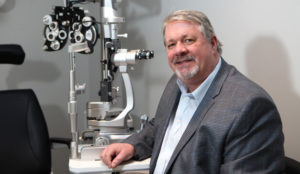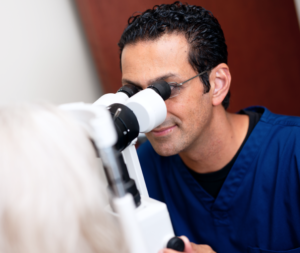
Conditions
We Treat
At Ighani Eye Care, we’re proud to provide comprehensive eye health services using the latest technologies and research-based practices. In addition, Dr. I and Dr. Anding offer a variety of diagnostic and treatment modalities for many eye-related medical conditions.
Schedule An AppointmentComprehensive, Compassionate Care for Eye Conditions
Dr. I and Dr. Anding are highly skilled clinical eye doctors (ophthalmologist), with expertise in a wide range of eye services, from medical eye exams to the diagnosis, treatment and management of complex eye diseases.
During your visit, our caring, dedicated team will explain all of your options and provide you with the information you need to make educated, important decisions about your vision. We look forward to serving you.
- Glaucoma
- Macular Degeneration
- Retinopathy
- Dry Eye
Glaucoma
Glaucoma is a condition associated with higher-than-normal fluid pressure in the eye (intraocular pressure or IOP) that is causing damage to the optic nerve. The condition affects more than two million Americans, and half of those are unaware they even have the disease!

Glaucoma is characterized by damage to the optic nerve with slow vision loss over time. When enough nerve damage has taken place, blind spots begin to develop in the field of vision. Unfortunately, most people don’t notice these blind spots until irreversible damage is done. For this reason, glaucoma is often described as the “silent thief of sight”.
At Ighani Eye Care, we put great emphasis on early detection. Every person over the age of 60 should have a comprehensive eye exam once a year, where we will screen for glaucoma.
There is no cure for glaucoma at this time, but we are able to control and stabilize the condition by keeping eye pressure in a healthy range. This range is a little different for each patient and is dependent on a few factors, including the severity of the condition, corneal thickness, patient age and more.

The goal of any glaucoma treatment is to lower eye pressure, preserve your current level of vision and prevent further damage. However, treatment can vary, depending on the type of glaucoma diagnosed, the degree to which the condition has progressed, underlying risk factors and other variables.
In general, prescription medicines (eye drops and oral medications), laser procedures and operative procedures are all utilized in an attempt to preserve vision.
SLT (Selective Laser Trabeculoplasty).
SLT is a form of laser surgery that is used to lower intraocular pressure in open-angle glaucoma. It is used when eye drop medications are not lowering the eye pressure enough or are causing unwanted side effects. It may sometimes be used as an initial treatment in glaucoma.
MIGS (Minimally Invasive Glaucoma Surgery)
MIGS are designed to lower eye pressure safely with rapid recovery and minimal restrictions. Instead of creating an artificial drain in the eye, they unclog the natural drainage system of the eye, enhancing drainage.
MIGS offers several advantages over traditional surgery. They are minimally invasive, nonpenetrating procedures that do not create a permanent opening in the wall of the eye. Additionally, they can be performed as stand-alone procedures or at the same time as cataract surgery with similar recovery, postoperative drop regimen and restrictions of activity as cataract surgery alone.
Macular Degeneration

Macular degeneration (AMD) is an age-related eye disease that runs in families. It results in central vision loss and is the leading cause of blindness in people aged 65 and older.
With macular degeneration, the small, central part of the retina, called the macula, deteriorates. There are two types of AMD: dry (by far, the most common type) and wet (bleeding).

Treatment for dry AMD begins with routine eye exams, especially after age 60. The goal here is early detection! If detected, we may prescribe a combination of nutritional supplements. This supplement is called AREDS2, which is a special combination of vitamins and minerals that have been shown to slow the progression of the condition.
Wet AMD treatment can include a number of options, including intravitreal injections that inhibit the growth of the abnormal blood cells that cause wet AMD.
Retinopathy

Diabetic retinopathy is the most common microvascular complication among people with diabetes. Diabetes causes the weakening of the tiny blood vessels that nourish the retina. As a result, fluid and blood leak from these weakened vessels, and new vessels that grow can be distorted and begin to bleed. This can injure the retina, leading to loss of vision.
Diabetic retinopathy typically develops without any warning signs. Damage to the eye occurs slowly and may go unnoticed until there is significant damage. For this reason, anyone with diabetes should receive regular monitoring by a trusted eye specialist.
Hypertensive retinopathy is damage to the retina that occurs as a result of high blood pressure. Left untreated, it can lead to vision loss. Controlling and lowering high blood pressure is the best way to avoid developing hypertensive retinopathy.

Diabetic retinopathy treatment at Ighani eye Care is highly individualized, factoring in your age, medical history, lifestyle and degree of damage to your retina. In its earliest stages, diabetic retinopathy may not require treatment beyond regular monitoring.
If treatment is required, Dr. Anding will explain all options, including risks, benefits and alternatives, before recommending the most appropriate treatment for you. Medical management typically includes intravitreal injections for diabetic macular edema and laser therapy to seal or shrink leaking blood vessels in a process called photocoagulation performed by a retina specialist.
Dry Eye
Dry Eye is more common today than ever before. And while your issue could be allergy-related, most experts agree that screen time (things like computers, smartphones, video gaming) is likely to blame for increased dry eye symptoms in most cases. These activities can interfere with quality and quantity of blinks, which can result in dry eye.

Not enough quality blinks means not enough natural tears. This leads to, you guessed it, dry eye. The technical term for this condition is Meibomian Gland Dysfunction (MGD for short!), and it is the leading cause of chronic dry eye.
The meibomian glands are found in the upper and lower eyelids. Their job is to secrete oil onto the surface of the eye, which helps keep your tears from evaporating too quickly. MGD is a blockage of those glands, so they don’t secrete enough oil. When tears evaporate too quickly, the result is dry eyes.
Symptoms of dry eye include:
- Burning or stinging
- Gritty feeling
- Foreign body sensation (like an eyelash or grain of sand is stuck in the eye)
- Excessive tearing (oddly enough)
- Eye fatigue

Dr. I will perform diagnostic testing and a complete exam that will help us pinpoint the source of your unique situation. This is an important diagnostic step because chronic dry eye symptoms are similar to those of allergies and even some eye infections.
Beyond warm compresses and prescription eye drops (Restasis and Xiidra), we are able to offer one other treatment for our patients living with chronic dry eye.
Punctal Plugs. These tiny devices are inserted in the ducts in your lids to slow the drainage of tears away from your eyes, keeping your eyes more moist.
